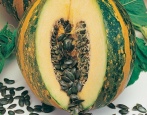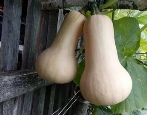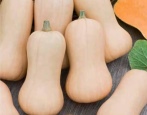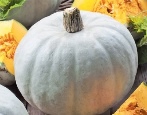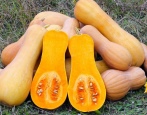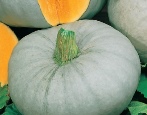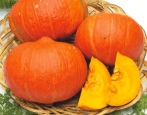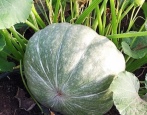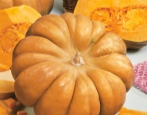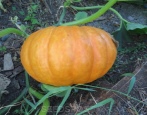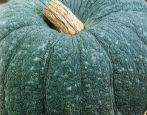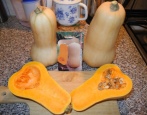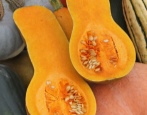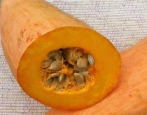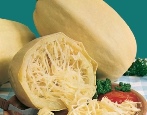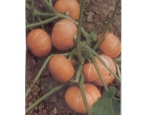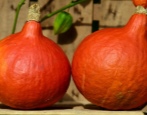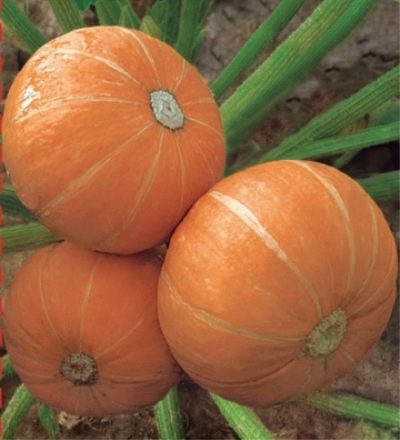
- Authors: Lukyanenko A.N., Dubinin S.V., Dubinina I.N.
- Year of approval: 2009
- Lash length, m: up to 1
- Leaf color: dark green
- The form: flat-round
- Weight, kg: 1,0-1,5
- Coloration: orange, sometimes with longitudinal light stripes
- Color of the pulp: bright orange
- Pulp (consistency): starchy, medium density and juicy
- Taste: sweet
Pumpkin Amazon is one of the popular varieties that is appreciated by gardeners for its high yield and strong immunity. Culture is an indispensable ingredient for preparing a variety of dishes.
Description of the variety
Amazon is one of the most compact varieties that does not require much space on the site. Culture characteristics:
bushes - classic green;
fruit formation - at the base;
frost resistance - excellent.
Gardeners also note the decorative function of the variety, with the help of which it is possible to decorate the surrounding space.
Characteristics of the appearance of plants and fruits
The Amazon pumpkin is not only a useful plant, but also an eye-catching plant. Characteristics of the popular variety:
type - portioned;
shape - flat-round;
weight - up to 1.0-1.5 kg;
the peel is smooth, orange in color.
The pulp of the vegetable also has a bright orange color, is famous for its high starch content, and has an average density and juiciness. Pumpkin tolerates long-distance transportation, which is also an undoubted plus.
Purpose and taste
Pumpkin Amazon is capable of boasting sweet taste and excellent keeping quality. The fruits are used for fresh consumption, as well as for the preparation of various dishes: from salads to soups and pastries.
Ripening terms
The variety belongs to the group of plants with a mid-ripening period. On average, fruits are formed in 80-100 days and appear closer to August-September.
Yield
The yield indicator on average reaches 363-683 centners per hectare.
Growing and caring
The Amazon is considered an unpretentious crop, so gardeners rarely have difficulty growing a unique variety. In most regions, they prefer to plant the pumpkin in open ground with seeds. First of all, the seed must be prepared.
Selection. First you need to check the seeds for germination. For this, gardeners recommend placing the samples in a saline solution. Whole ones will remain at the bottom, empty ones will float to the surface.
Disinfection. It is carried out by soaking the seeds in a solution of wood ash. For cooking, you need 2 tablespoons of ash and 1 liter of water. With the help of the procedure, it will be possible to destroy dangerous microorganisms and strengthen the culture's immunity.
Hardening. For 2 days, it is recommended to keep the seeds at a temperature of 1 degree to prevent future damage to the plant from various diseases or frost.
At the end of all stages, it is recommended to place the seeds in a cloth bag, previously soaked in warm water, and then transfer the material to a windowsill. After two days, it will remain to treat the seeds with growth stimulants in order to accelerate the germination of the pumpkin.
Landing in open ground is carried out mainly in May-June - depending on the climatic conditions of the region. Landing scheme.
80 cm recede between the rows.
Between samples in a row up to 80 cm are kept.
Seed planting depth - 3 cm, seedlings - 5 cm.
After planting, the seeds are covered with fertile soil and watered abundantly. Next, it remains to take care of the care of the plant.
Watering.The pumpkin should be watered with rainwater or previously settled water to prevent the risk of contamination of the crop. On average, the beds are watered every 10 days, taking into account the weather conditions. Water is introduced into the soil usually in the morning to prevent the sun from burning the leaves.
Weeding. A mandatory procedure that involves removing weeds and loosening the beds. It is carried out mainly after each watering. With the help of weeding, it will be possible to accelerate the flow of useful components to the roots of the plant, as well as to avoid the risk of pumpkin disease.
Top dressing. Another mandatory step that requires the introduction of mineral and organic complexes. The latter are usually used nettle, ash, onion and garlic. With the help of fertilizers, it will be possible to increase the yield indicator.
In addition to root dressing, gardeners are advised to use foliar. The procedure is carried out using a spray bottle. Spraying will help protect the plant from unwanted pests.
Requirements for soil and climatic conditions
The Amazon prefers to grow in sandy or light loamy soils. Additional recommendations for choosing a site:
the place should be well lit and windless;
preference should be given to hills; in case of landing in a lowland, you should take care of drainage;
before planting seeds, you must thoroughly fertilize and loosen the soil.
Additionally, gardeners recommend paying attention to the acidity indicator. In the case of a high acid content, alkaline fertilizers should be used, which will act as neutralizers.
Disease and pest resistance
The Amazon is distinguished by its endurance and strong immunity, however, with improper care, the likelihood of bacteriosis damage to the culture is high. The disease leads to rotting of the fruit, due to which the yield is noticeably reduced. To prevent the development of the disease, preventive treatment of the culture with a soap solution will help, for the preparation of which you will need 5 liters of water and 100 g of dry pre-grated soap.
